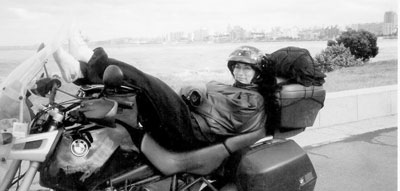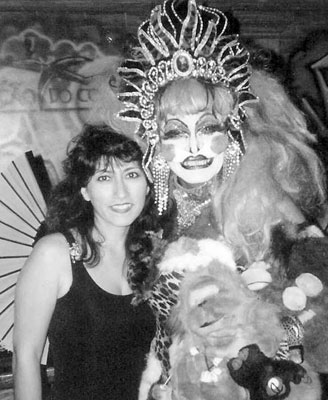A novel approach to travel
What books or movies inspired you to travel to another country (outside of North America and the Caribbean)? ITN asked that question and received many responses, which were printed in the June through September 2005 and February 2006 issues. Here are a few more.
If you have suggestions to share, write to A Novel Approach to Travel, c/o ITN, 2116 28th St., Sacramento, CA 95818, or e-mail editor@intltravelnews.com (please include the address at which you receive ITN).
Although I had always wanted to visit the BRITISH ISLES, I’d never thought much about specific areas. That was the case until I read two different books by D.E. Stevenson.
The first was “Fletcher’s End,” which was set in the Cotswold Hills of England. After reading the descriptions of the warm, honey-colored stone used for the buildings in the quaint villages, I had to see it for myself. The second was “The Enchanted Isle,” set in Scotland with the heather, craggy cliffs, mysterious lochs and never-ending foreboding skies. (“The Enchanted Isle” was originally published in the U.S. as “Blow the Wind Southerly” and also was published in Great Britain as “Charlotte Fairlie.”)
The longing for Scotland was furthered by a series of books written by Diana Gabaldon that starts with “Outlander.” The first book is set in the Highlands and Edinburgh and is an unusual combination of historical fiction, time travel, mystery and romance. The city of Edinburgh sounded so intriguing with its history, back lanes and bagpipes. I even interested my husband in Scotland as he listened to the books on tape while we walked.
Finally, the trip of a lifetime materialized, thanks to a generous gift from my parents, and in the summer of 1998 we were off to England, Scotland and Wales. The British Isles were everything I had hoped for and more.
The Cotswolds were filled with enchanting and charming villages made of honey-colored stone buildings surrounded by flowers and sitting on crooked narrow lanes. I could just picture Bel Lamington, the heroine from the Stevenson book, purchasing her cottage. Sitting in Dr. Doolittle’s pub in Castle Coombe was one of the most satisfying experiences of my travels because it felt like I had entered a D.E. Stevenson book.
In Scotland a few days later we drove and drove, and when we entered the Highlands my husband turned to me and stated, “We’re in Jamie and Claire country, aren’t we?” These are the two main characters from the Gabaldon series.
The air was clear, the sky was blue, the sun was shining and the feel of the place was ancient but new. The small stone crofts, the lochs so calm they looked like sheets of glass, and the rugged hills dotted with sheep were all as I imagined from reading the books.
I believe books helped me become an anglophile and fostered the dream of visiting the places I read about, while the travel finally fulfilled the dreams.
CINDY ROBINSON
Scottsdale, AZ
“Practical jokes in stone, ‘monuments to a mood’ (a definition coined by Sir Kenneth Clark), the Bedlam of architecture — all describe structures erected in complete disregard of the usual building practices and tastes on sites that bear no relation to ease of access, for purposes so bizarre or whimsical as to make their cost out of all proportion to their spurious utility.”
Just reading that first paragraph, I knew I had to see at least some of these “practical jokes.” I ordered the book “Follies, a National Trust Guide” (now out of print, but the author in 1999 came out with “Follies, Grottoes and Garden Buildings” on Aurum Press, London — ISBN 1-85410-625-2). There are about 1,250 follies mentioned and hundreds photographed by Gwyn Headley and Wim Meulenkamp.
In 1988, a girlfriend and I set out in a rented car (be sure to ask for power steering) with this book and a detailed map of ENGLAND.
We climbed on steps over a fence, walked a great distance and came to a bust of Maude Heath sitting with a basket on top of a tall column. A folly out in no-man’s-land!
In another area, we went down steps to a grotto. The walls were damp and covered with seashells with marvelous designs. There were three rooms. No one remembers who built this.
Mr. Whitley of Buckland commissioned the stonemason firm Exeter to engrave the Ten Commandments on the two enormous flat rocks to commemorate the defeat in Parliament of the Revised Prayer Book. It was extremely difficult to get to.
There is also an underwater ballroom at Wetley Park.
Each day was a delightful adventure.
ELAINE BAUM
Houston, TX
The 1973 thriller “Don’t Look Now,” with Julie Christie and Donald Sutherland, was set in the labyrinth of VENICE. That exciting film fired my imagination and desire to see the city of canals, which I finally did in October ’04. Venice lived up to the beauty and intrigue of that film.
Charlie Chan fans will love the Old Town section around Yu Gardens in SHANGHAI. It was easy to see how the term “shanghaied” came about after wending our way around the twisting, sinister alleyways in that colorful district of the city.
My young son picked out the video “The Man Who Knew Too Much” with Doris Day and James Stewart for our pizza family night. It kept us on the edge of our seats so much that we went to MARRAKECH a few months later and have returned twice since then.
“The Third Man” with Orson Welles fueled two trips to VIENNA — such a lovely city, with much culture, beauty and the ability to watch the world pass by from fabulous Demel’s Café.
MONTE CARLO was every bit as glamorous as portrayed in “To Catch A Thief” with Cary Grant and Grace Kelly. The megayachts and hillside buildings give the place an exciting atmosphere.
The various Sherlock Holmes films necessitated numerous trips to LONDON to view Baker Street, the Tower of London and other haunts of the fictional detective.
Next on our list of places to visit is Transylvania, after viewing the Dracula movies.
NANCI LUCERO
Santa Fe, NM
Prior to my first and only trip to EGYPT in 1999, I read at least four books by Naguib Mahfouz. One of them was entitled “Midaq Alley.”
When our Elderhostel group had a free day, some of us headed to the bazaar. I went along mainly to find Midaq Alley. While our subgroup stayed together for visits to a bar to watch hookahs being used as well as for visits to various businesses looking for bargains, no one was going to look for the alley with me. I can’t blame them, as it turned out. So I was on my own.
The streets were narrow, allowing for one-way vehicular traffic in some cases. As one small truck passed through the area, I was splattered with mud. Imagine my surprise when a local came to me with a Kleenex and assisted me in removing the stains from my attire. No tip requested — it was just a genuine act of concern.
Although I had instructions, bear in mind that none of the street signs were in English, so I quickly became disoriented. One narrow alley looked just as another. I then ran into a man who was standing in front of his shop and spoke very good English. He offered to help me for $10, even throwing in a bottle of beer, which he quickly produced at his business. (It was not a twist-top, and he did not have an opener. He called over a shop helper and handed him the bottle, which the young man proceeded to open using his teeth.)
We then started on our route to Midaq by taking shortcuts I never would have found. Within two blocks of his business we were there.
My companion left me then, and I walked about the area that had been immortalized by Mahfouz. A small cul-de-sac in the middle of the bazaar, Midaq Alley was shabby, drab, dispiriting and probably not worth a tenner to see. Yet it was also what the author depicted in telling of the lives of the poor inhabitants who had lived there in his fiction of many years earlier.
I took a few pictures and left, finding my way out of the maze on my own. And I had had a Cairo adventure I would not have had except for having read a book.
PHILIP H. DeTURK
Pinehurst, NC
Ah, how your imagination can be inflamed by a good novel!
Two books which I really credit for getting me to EGYPT in 1998 were “River God” and “Seventh Scroll” by Wilbur Smith. “River God” is about ancient Egypt in the Luxor and Valley of the Kings area. “Seventh Scroll” deals with modern-day tomb robbing (hinted at by dear old Taita in the first book). Any of Wilbur Smith’s 30-plus books can stir up some part of Africa in you.
“Tanamera” by Noel Barber didn’t actually get me to SINGAPORE, but while I was there I looked up some of the places mentioned in the book. The Bukit Timah road was still there (at least it was in 1984) and, of course, the Raffles Hotel. I pictured the characters from the book actually “in place.”
Almost any book about the Raj and the British in India has piqued my interest lately — to such an extent that I planned a trip there.
CAROL STARK
Loveland, CO
I love to read novels about places I’m planning to visit, but it’s sometimes hard to find them as bookstores aren’t generally arranged with this in mind!
For a visit to MALTA I heartily recommend “The Kappillan of Malta” by Nicholas Monsarrat. Written by a superb novelist who had a home on Malta, the story takes the reader through Malta’s long and involved but always fascinating history and its geography as well.
He uses the device of a priest comforting hideaways (in mountain catacombs during World War II bombings) by telling stories of the history of their beleaguered island.
The bad news is that this book is long out of print. The good news is that there are plenty of used copies of both the paperback and hardcover editions available online (note the spelling!), and in Malta there are copies just about everywhere books are sold.
JOAN LEVIN
Chicago, IL
I often read location-specific novels to get in the mood for an anticipated trip, but one book stands out in my mind. Several years ago, to get away from the New England winter, I was trying to find a trip destination that was cheap (I am a piggy-bank traveler). A friend loaned me “The Kappillan of Malta” by Nicholas Monsarrat and I was hooked.
First published in 1973, this fascinating novel is nominally set during the brutal bombing raids of World War II which drove the Maltese into the ancient catacombs under the city for protection. Each chapter uses the literary device of a “pep talk” given by the local priest (kappillan means “parish priest” in Maltese) to describe the many times during Malta’s 7,000-year history when the local population survived against all odds.
MALTA is at the crossroads of the Mediterranean and thus has been vulnerable to countless invasions over the centuries. Alas, most tourists seem to miss the many layers of history that this tiny country has as its heritage. It is worth a trip just to see the prehistoric Megalithic Temples, a UNESCO World Heritage Site. I spent two independent weeks on Malta and even then didn’t have time to see all there was to see.
CONNIE MITCHELL
Center Barnstead, NH
Back in 1997 I read “Investment Biker” by Jim Rogers. Rogers was a Wall Street investor who decided to travel with his girlfriend AROUND THE WORLD on his BMW motorcycle in the early ’90s. The book is about their travels and his learning about local businesses and communities and deciding to make investments in them as he traveled.
The book portrays, as part of their 2-year motorcycle journey, the unique challenges presented in crossing the Sahara Desert by motorcycle (including their particular vulnerability to desert sandstorms), coping with mood swings in the close relationship and dealing with the emotions of traveling freely with no particular itinerary except perhaps the next destination.
Inspired by the book, I commented to a friend about the lure and excitement of being able to travel for such a long period of time, especially on a motorcycle. What I did not know was that my opportunity to participate in such a dream vacation would present itself the following year.
In the winter of 1998, three friends and I on the spur of the moment decided to fly to Rio to experience Carnaval. We had only two weeks to make our plans. Getting flights and a hotel at the last moment was difficult, but we ended up with accommodations at the InterContinental Hotel near Ipanema.
Several days before my flight, I received an unexpected telephone call from Panama. It was a California friend, Dean, who told me that he was traveling in Central America on his new BMW R1100GS motorcycle. He had departed from his home in San Diego and was heading south to Ushuaia. From Panama, he was trying to catch a ferry to Colombia since there were no accessible roads connecting the two countries. It was his intention to travel around South America for the next few months.
I then told him of our spontaneous plan to go to Rio, and we discussed the potential of our traveling together after Carnaval if he could make it there on time.
Unfortunately, I “overpacked” for my trip to Rio, taking two large pieces of luggage for a 10-day trip. Dean arrived on the last day of Carnaval, and I was introduced to my transportation mode for the next week. With the bike’s limited space available for storage, I was given a saddlebag which measured 20"x30"x10". All of my “necessary” belongings had to fit into this space. It was nonnegotiable!
My initial concerns were for comfort. How would it be riding a motorcycle for six hours per day when simply riding in a car for more than three hours made me skittish? We negotiated some “road rules,” including stopping enough times to stretch our legs and not driving at night.
To my surprise, the first day was a 4-hour cruise on a straight road which hugged the Atlantic coast. I put on a heavy layer of sunscreen, wore the helmet on top of my CD headset, sat on the back of the bike and relaxed!
Traveling on a motorcycle has its benefits. We never got stuck in traffic, we could always squeeze onto an otherwise full ferry and we could stop almost anywhere. With his new BMW, we also received a lot of attention from admiring locals.
The trip was far from uncomfortable. I was having so much fun that I extended the trip for another two weeks and for three more countries. From Rio we headed south to Curitiba, then west to Iguazú Falls. We went through a portion of Argentina to reach Paraguay, then crossed Uruguay and took the ferry from Colonia to Buenos Aires, Argentina.
During these three weeks, we traveled nearly 2,800 miles and had wonderful adventures along the way. The trip was not without its discomforts, however. After experiencing a stiff neck from looking to one side or the other, I had to do neck-stretching exercises every day.
Surprisingly, we never lost control of the motorcycle, and I can’t remember being hit with any bugs as we sped through even the most tropical parts of our trip. There were, however, a few harrowing moments when we suddenly found ourselves in the midst of torrential downpours on stretches of road several miles away from any village.
We created a stir with nearly every border crossing. It seemed like no one had ever seen a BMW motorcycle. And most were curious when they saw a fluent Spanish-speaking “gringo” driving a “local” (since I am Peruvian, I could easily pass for a local). We even had policemen stopping us just to check out Dean’s bike! To say the least, we always had plenty of people approaching us to say “Hello.”
I also learned that I could indeed travel light and survive. In my small compartment I had only two pairs of shorts, two tops, one pair of tennis shoes, one little black dress, high heels and eyeliner. It was all fresh air blown hair, with no real makeup and no frills.
My dream of traveling on a motorcycle like Jim Rogers had become a reality!
In early March I boarded my flight back to the States while Dean continued on to Ushuaia, where he joined a cruise to Antarctica. On his return trip north, he followed the Pacific coast north via Chile and Peru.
Recently, I saw the movie “Motorcycle Diaries,” which brought back many wonderful memories of this spontaneous trip.
LILLIE ECHEVARRIA
Livermore, CA
Several years ago I was planning a train trip through northern ITALY when I came across the book “The Duchess of Milan” by Michael Ennis. It was fiction but was obviously meticulously researched. I learned a lot about the history of Italy during the period of Machiavelli. The story centered on Beatrice d’Este and Isabella of Aragon and their husbands, Lodovico Sforza (Il Moro) and Francesco Sforza, the Duke of Milan. There were many mentions of a place called Pavia, where there was a beautiful chapel. I became curious about it and found it was possible to go there from Milan by bus.
After spending several wonderful days in Milan, I boarded a bus for Pavia but got off at the stop for Certosa. I then had to walk almost a mile to the chapel. By the time I got there it had started to rain, so I didn’t spend much time looking at the outside of the building, which was really fascinating.
The interior was also extravagantly decorated (although it was not as mind-boggling as the 15th-century charterhouse that is part of the Cartuja de Miraflores complex near Burgos, Spain, which is a “must see” for all visitors). I found the tomb of Beatrice and Il Moro, with their funerary sculptures lying side by side on top, and many other beautiful paintings and sculptures.
After my visit, I walked back to the highway to take the bus to the town of Pavia. In the covered bus stop, I had a nice chat with a woman who spoke only Italian, which I didn’t understand. She kept pointing to something in the stream down below until I had to pretend I saw it and nodded and smiled a lot.
Pavia turned out to be a rather ordinary town, especially in the rain, but it had a great huge statue of a woman warrior in the middle of the road. After having a delicious rice salad, I took the bus back to Milan.
It was very satisfying to see a place that I had imagined from the pages of a book.
ARLINE AMES
Glendale, CA




